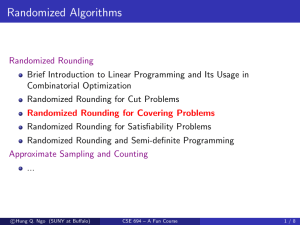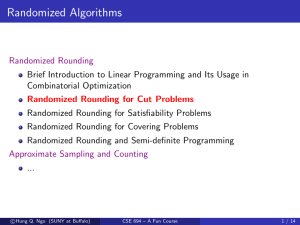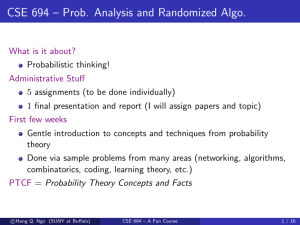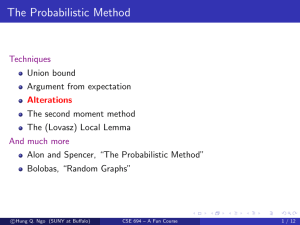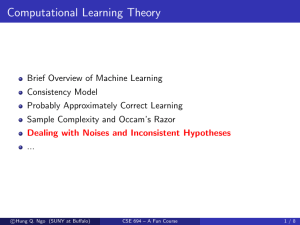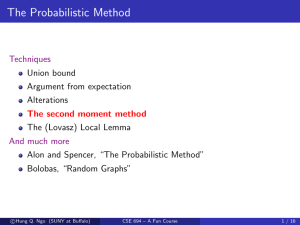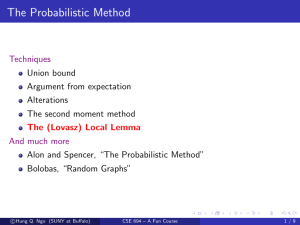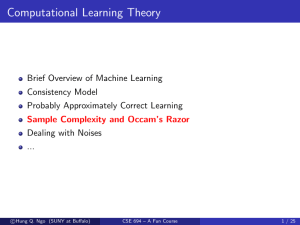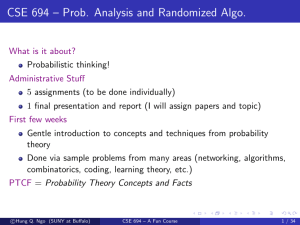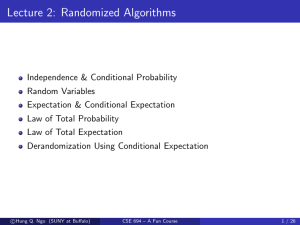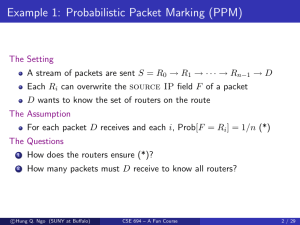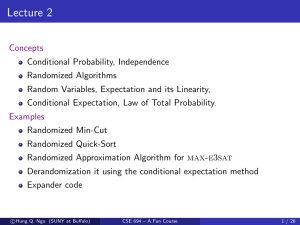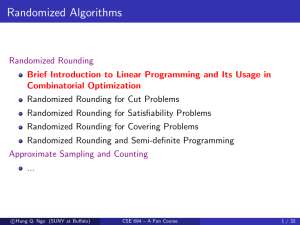CSE 694 – Prob. Analysis and Randomized Algo.
advertisement
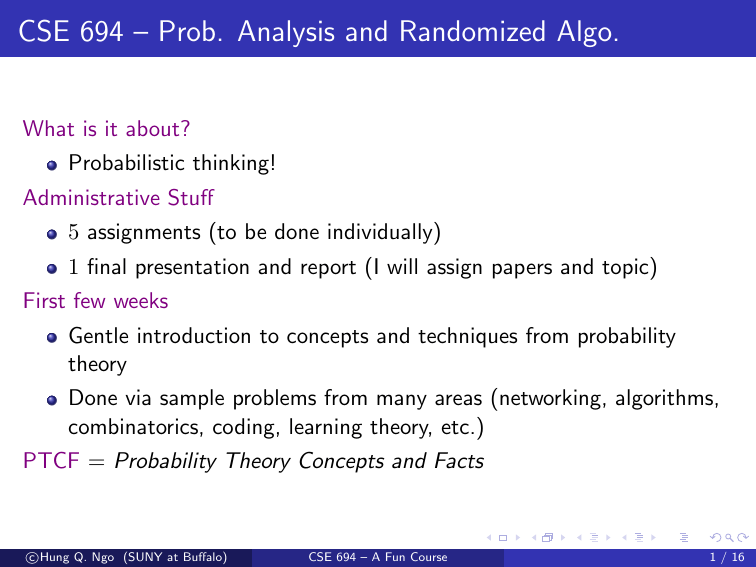
CSE 694 – Prob. Analysis and Randomized Algo.
What is it about?
Probabilistic thinking!
Administrative Stuff
5 assignments (to be done individually)
1 final presentation and report (I will assign papers and topic)
First few weeks
Gentle introduction to concepts and techniques from probability
theory
Done via sample problems from many areas (networking, algorithms,
combinatorics, coding, learning theory, etc.)
PTCF = Probability Theory Concepts and Facts
c
Hung
Q. Ngo (SUNY at Buffalo)
CSE 694 – A Fun Course
1 / 16
Outline
1
Lecture 1: Probability Space, Union Bound, Probabilistic Method
c
Hung
Q. Ngo (SUNY at Buffalo)
CSE 694 – A Fun Course
2 / 16
Example 1: Ramsey Numbers
The Ramsey number R(k, k) is the smallest integer n such that no
matter how we assign red or blue to each edge of Kn , there must
exist a monochromanic Kk .
Analogy: R(k, k) is the smallest n so that in any set of n people
there must be either k mutual acquaintances, or k mutual strangers
Erdős’ Quote
Imagine an alien force, vastly more powerful than us landing on Earth and
demanding the value of R(5, 5) or they will destroy our planet. In that
case, we should marshal all our computers and all our mathematicians and
attempt to find the value. But suppose, instead, that they asked for
R(6, 6), we should attempt to destroy the aliens.
c
Hung
Q. Ngo (SUNY at Buffalo)
CSE 694 – A Fun Course
3 / 16
Notes
There are (much) more general Ramsey numbers. E.g., R(a, b) is the
smallest integer n such that no matter how we 2-color edges of Kn
with red and blue, there exists either a red Ka or a blue Kb .
Or multi-dimensional Ramsey numbers (the above is 2-dim)
The problem is a generalization of the pigeonhole principle
Intuition/interpretation:
when n is sufficiently large, there must be a monochromatic sub-clique
of a given size
i.e., in a sufficiency large “space,” local “patterns” must emerge. (this
theme is manifested in different ways in this course)
problem is to find/estimate the threshold
c
Hung
Q. Ngo (SUNY at Buffalo)
CSE 694 – A Fun Course
4 / 16
Erdős’ Theorem (1947)
Theorem
(i) If
n
k
k
21−(2) < 1, then R(k, k) > n.
(ii) Consequently, R(k, k) > b2k/2 c for all k ≥ 3.
To see (ii), let n = b2k/2 c.
Then,
n 1−(k) nk 21+k/2
21+k/2
nk
2 2 <
· k2 /2 <
· k2 /2 < 1.
k
k! 2
k!
2
We will give two proofs of (i).
c
Hung
Q. Ngo (SUNY at Buffalo)
CSE 694 – A Fun Course
5 / 16
A Pigeonhole Principle Proof
k
We’ll show that nk 21−(2) < 1 implies, there exists a 2-edge-coloring of
Kn without a monochromatic Kk .
Let [n] be the set of vertices
Let Ω = set of all 2-edge-colorings of Kn
For any S ∈ [n]
k , the number of colorings for which S is
n
k
monochromatic is 2 × 2( 2 )−(2)
The number of colorings for which some S ∈ [n]
k is monochromatic
is at most
n
k
n
n 1−(k)
n
−
(
)
(
)
(
)
×2×2 2 2 =2 2
2 2 .
k
k
n
But, the total number of colorings is 2( 2 ) , and
n
n
n 1−(k)
n 1−(k)
(
)
(
)
2 2
2 2 <2 2 ⇔
2 2 <1
k
k
c
Hung
Q. Ngo (SUNY at Buffalo)
CSE 694 – A Fun Course
6 / 16
Probabilistic Method Proof #1
Pick a coloring c ∈ Ω uniformly at random.
For any S ∈ [n]
k , let AS be the event that S is monochromatic, then
n
k
k
2 × 2( 2 )−(2)
# colorings making S mono.
=
= 21−(2)
Prob[AS ] =
n
(
)
total # colorings
2 2
The probability that some S ∈ [n]
k is monochromatic is
"
#
[
X
n 1−(k)
Prob
AS ≤
Prob[AS ] =
2 2 <1
k
S
S
Thus, there must be some coloring for which no S is monochromatic!
c
Hung
Q. Ngo (SUNY at Buffalo)
CSE 694 – A Fun Course
7 / 16
PTCF: Simple Probability Space
Event A
Sample Space Ω
Ω is a finite set of all possible outcomes of some experiment
Each outcome occurs equally likely
A subset A of outcomes is an event
Think of it as a set of outcomes satisfying a certain property
Prob[A] = |A|
|Ω| : the fraction of outcomes in A
In most cases, not a good way to think about probability spaces
c
Hung
Q. Ngo (SUNY at Buffalo)
CSE 694 – A Fun Course
8 / 16
PTCF: The Union Bound
Lemma
Let A1 , A2 , . . . be any finite or countably infinite sequence of events.
Then,
[
X
Prob[Ai ]
Prob Ai ≤
i≥1
i≥1
Note:
this bound holds for any probability space (not just simple spaces).
the bound is simple but extremely useful!
c
Hung
Q. Ngo (SUNY at Buffalo)
CSE 694 – A Fun Course
9 / 16
Probabilistic Method Proof #2 (much better than #1!)
Color each edge of Kn with either red or blue with probability 1/2
For any S ∈ [n]
k , let AS be the event that S is monochromatic, then
Prob[AS ] = Prob[S is blue] + Prob[S is red] = 2 ×
k
1
= 21−(2)
k
2( 2 )
The probability that some S ∈ [n]
k is monochromatic is
"
#
[
X
n 1−(k)
Prob
AS ≤
Prob[AS ] =
2 2 <1
k
S
S
Thus, there must be some coloring for which no S is monochromatic!
c
Hung
Q. Ngo (SUNY at Buffalo)
CSE 694 – A Fun Course
10 / 16
PTCF: Discrete Probability Space
pω
Event A
Sample Space Ω
Each ω ∈ Ω is assigned a number pω ∈ [0, 1], such that
P
For any event A, Prob[A] = ω∈A pω .
In the simple space, pω =
P
ω∈Ω pω
= 1.
1
|Ω| , ∀ω
Note: this is not the most general definition, but suffices for now.
c
Hung
Q. Ngo (SUNY at Buffalo)
CSE 694 – A Fun Course
11 / 16
PTCF: How do we “assign” the pω ?
Could think of it as a mathematical function, like saying “give each
outcome ω a number pω equal to 1/|Ω|”
That’s not the probabilistic way of thinking!
Probabilistic way of thinking:
An experiment is an algorithm whose outcome is not deterministic
For example, algorithms making use of a random source (like a bunch
of “fair” coins)
Ω is the set of all possible outputs of the algorithm
pω is the “likelihood” that ω is output
c
Hung
Q. Ngo (SUNY at Buffalo)
CSE 694 – A Fun Course
12 / 16
Example 2: Sperner Lemma
Lemma (Sperner, 1928)
The maximum size of a family
F of subsets of [n] whose members do not
n
contain one another is bn/2c .
The collection of bn/2c-subsets of [n] satisfies the condition
n
.
Suffices to show that, for any such F, |F| ≤ bn/2c
Fix F ∈ F, choose a permutation π ∈ Sn uniformly at random
Let AF be the event that F = {π1 , . . . , πk } for some k, then
Prob[AF ] =
k!(n − k)!
1
= n ≥
n!
k
1
n
bn/2c
The AF are mutually exclusive (why?), hence
"
#
[
X
AF =
1 ≥ Prob
Prob[AF ] ≥
F ∈F
c
Hung
Q. Ngo (SUNY at Buffalo)
F ∈F
CSE 694 – A Fun Course
|F|
n
bn/2c
13 / 16
Example 3: Non-Adaptive Group Testing
A t × n matrix A is called d-disjunct iff the union of any d columns
does not contain another column
Columns are codewords of superimposed codes
Rate of the code is R(a) =
log n
t
Want codes with high rates. But, as n → ∞ and d → ∞
1
d2 log e
(1 + o(1)) ≤ lim sup R(A) ≤
A
2 log d
(1 + o(1))
d2
(From Dyachkov, Rykov (1982), and Dyachkov, Rykov and Rashad
(1989))
We’ll prove the lower bound
c
Hung
Q. Ngo (SUNY at Buffalo)
CSE 694 – A Fun Course
14 / 16
Existence of Good d-disjunct Matrix
Set aij to 1 with probability p
The probability that A is not d-disjunct is at most
h
it
n
1 − p(1 − p)d ≤
(d + 1)
d+1
1 d t
n
1
(1 −
)
(d + 1)
1−
d+1
d+1
d+1
This is < 1 as long as
n
t ≥ 3(d + 1) ln (d + 1)
d+1
In particular, for large n, there exist d-disjunct matrices with rate
log n
1
≈
t
3(d + 1)2
c
Hung
Q. Ngo (SUNY at Buffalo)
CSE 694 – A Fun Course
15 / 16
Key Ideas We’ve Learned
In a sufficiently large “space,” locally nice “patterns” often emerge
To show the existence of some combinatorial object, set up some
probability space and show that it exists with probability > 0
The above is essentially a pigeonhole principle kind of proof, casted in
probabilistic language
We will see throughout the course that the probabilistic language is
crucial!
Thinking about probabilities “locally” is better than “globally”
c
Hung
Q. Ngo (SUNY at Buffalo)
CSE 694 – A Fun Course
16 / 16


